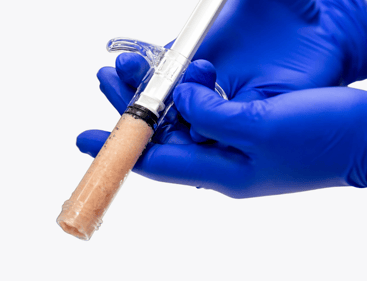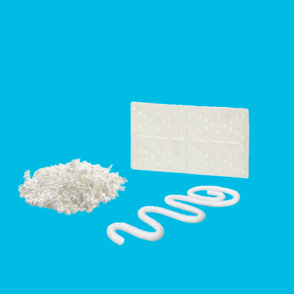Share this
Bone Grafting 101
by Marketing on May 3, 2024 11:20:15 AM
What are bone grafts?
Bone grafts are used to aid the healing and repair process for injuries or bone fractures, as well as the fusion of adjoining bones to help treat chronic pain. A bone graft can fill a gap where bone is missing or help provide structure and stability, and they come in a variety of shapes, sizes, and forms. Common areas where bone grafts are used include hips, knees, spine, and foot/ankle.
What are the main types of bone grafts? What are the benefits and drawbacks?
Autograft is a sample of your own bone tissue and is known as the ‘gold standard’ when it comes to bone grafting. Obtaining autograft typically involves a secondary surgical procedure where tissue is removed from the top of the hip bone (iliac crest). Using a patient’s own tissue increases the chances of successful healing and fusion, and a lower risk of infection and disease transmission. However, the amount of bone tissue that can be collected is limited, and a patient may experience pain at the additional surgical site.Allograft is bone tissue from another person or donor, typically
 healthy individuals who have died suddenly Following strict regulations and guidelines, the donor tissue is cleaned, processed, and sterilized to ensure its safety. Often utilized in spine fusion surgery, this type of graft provides the framework and environment for new bone tissue to form and grow. With allograft, no additional procedure is necessary to harvest bone directly from the patient, in turn reducing surgical time, eliminating a secondary surgical site, and minimizing postoperative pain. Allograft is also a great alternative for patients with poor bone health, where obtaining autograft is not the best option. Strict processing and rigorous checks significantly reduce the complications when using transplanted tissue, however, as with any surgical procedure, there is always a slight risk of disease transmission, infection, or allergic reaction.
healthy individuals who have died suddenly Following strict regulations and guidelines, the donor tissue is cleaned, processed, and sterilized to ensure its safety. Often utilized in spine fusion surgery, this type of graft provides the framework and environment for new bone tissue to form and grow. With allograft, no additional procedure is necessary to harvest bone directly from the patient, in turn reducing surgical time, eliminating a secondary surgical site, and minimizing postoperative pain. Allograft is also a great alternative for patients with poor bone health, where obtaining autograft is not the best option. Strict processing and rigorous checks significantly reduce the complications when using transplanted tissue, however, as with any surgical procedure, there is always a slight risk of disease transmission, infection, or allergic reaction. Synthetic bone graft is an artificially produced, biocompatible graft made from a variety of porous substances such as ceramics, polymers, or bioactive glass. Synthetic grafts are sterile, free of germs, and available in various forms and sizes in unlimited quantities. They are often used to supplement or extend the supply of autograft and are a versatile option for many surgical needs. The benefits of synthetic grafts include eliminating the need for a secondary surgical site, which reduces the surgical time and minimizes postoperative pain.
Synthetic bone graft is an artificially produced, biocompatible graft made from a variety of porous substances such as ceramics, polymers, or bioactive glass. Synthetic grafts are sterile, free of germs, and available in various forms and sizes in unlimited quantities. They are often used to supplement or extend the supply of autograft and are a versatile option for many surgical needs. The benefits of synthetic grafts include eliminating the need for a secondary surgical site, which reduces the surgical time and minimizes postoperative pain.
Which type of bone graft is best?
Despite the advantages of synthetic bone grafts, the use of natural bone grafts (autografts and allografts) remains desirable in many clinical scenarios. Natural bone tissue offers biological properties that synthetic substitutes cannot entirely replicate. These include the presence of natural growth factors, a bone matrix that is more conducive to cellular infiltration and attachment, and the intrinsic ability to remodel into the patient's own bone over time. Moreover, natural bone grafts have a structure that is immediately recognized by the body's healing systems, which can lead to a more predictable integration and healing process.
While synthetic grafts are advancing and becoming more similar to natural bone in their behavior, they may still not provide the same osteoconductive and osteoinductive properties found in natural bone tissue. These properties are crucial for certain types of bone healing and regeneration, particularly in load-bearing areas where the mechanical properties of natural bone are superior. In essence, while synthetic bone grafts are a significant development, especially for patients who cannot undergo additional surgical procedures, natural bone grafts remain the preferred choice in many surgeries for their unique biological benefits that favor long-term success and durability.
All three types of bone grafts offer different advantages and disadvantages, and the type of graft that will work best heavily depends on the patient and the procedure. A physician will take into consideration many factors to determine which graft is best for each individual and each situation.
https://my.clevelandclinic.org/health/treatments/16796-bone-grafting; https://www.piedmont.org/spine/services-treatments/surgical-treatments/spine-typesofbonegrafts; https://www.hopkinsmedicine.org/health/treatment-tests-and-therapies/bone-grafting
Share this
- Orthobiologics (20)
- Isto Biologics (12)
- Allograft (9)
- Autologous Therapy (8)
- Bone Graft (8)
- Regenerative Medicine (8)
- Acquisition (6)
- Cortical Fiber (3)
- Fibrant (3)
- Influx (3)
- Orthopedics (3)
- Covid-19 (2)
- DBM (2)
- PRP (2)
- Synthetic bone graft (2)
- TheraCell (2)
- cbma (2)
- Advanced Biologics (1)
- Biologica Technologies (1)
- Biosynthetic bone graft (1)
- Bone Marrow (1)
- Covid (1)
- InQu (1)
- Magellan (1)
- Precise (1)
- Press Release (1)
- ceo (1)
- concentrated bone marrow aspirate (1)
- growth factors (1)
- merger (1)
- president (1)
- promotion (1)
- proteins (1)
- October 2025 (1)
- September 2025 (1)
- October 2024 (1)
- July 2024 (1)
- June 2024 (1)
- May 2024 (2)
- April 2024 (1)
- October 2023 (1)
- July 2023 (1)
- June 2023 (1)
- June 2022 (1)
- April 2022 (1)
- April 2020 (1)
- March 2020 (2)
- September 2019 (1)
- April 2019 (1)
- February 2019 (1)
- September 2017 (1)
- June 2017 (1)
- February 2017 (1)
- June 2016 (1)
- February 2016 (1)

No Comments Yet
Let us know what you think